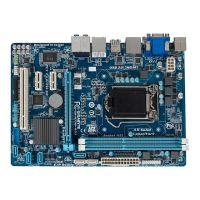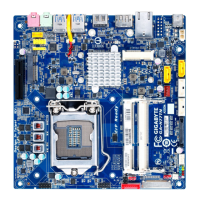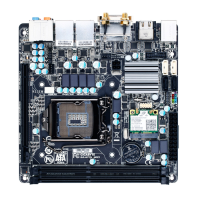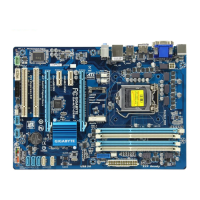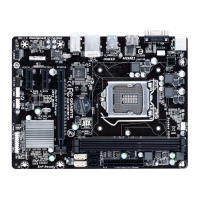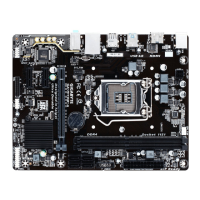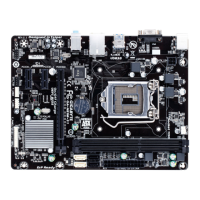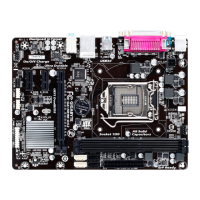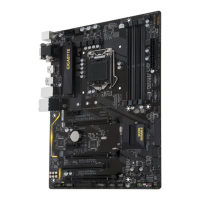
Do you have a question about the Gigabyte GA-H77M-D3H and is the answer not in the manual?
| ECC | Yes |
|---|---|
| Memory voltage | 1.5 V |
| Memory channels | Dual-channel |
| Memory slots type | DIMM |
| Number of memory slots | 4 |
| Supported memory types | DDR3-SDRAM |
| Maximum internal memory | 32 GB |
| Supported memory clock speeds | 1066, 1333, 1600 MHz |
| Supported memory module capacities | 16GB, 1GB, 2GB, 4GB, 8GB |
| System bus rate | 5 GT/s |
| Processor socket | LGA 1155 (Socket H2) |
| Processor manufacturer | Intel |
| Compatible processor series | Intel Core i3, Intel Core i5, Intel Core i7 |
| Maximum number of SMP processors | 1 |
| USB 2.0 connectors | 3 |
| Number of Parallel ATA connectors | 0 |
| USB 2.0 ports quantity | USB 2.0 ports have a data transmission speed of 480 Mbps, and are backwards compatible with USB 1.1 ports. You can connect all kinds of peripheral devices to them. |
| Audio chip | VIA VT2021 |
| Cooling type | Passive |
| Component for | PC |
| Power source type | ATX |
| Motherboard chipset | - |
| PC health monitoring | CPU, FAN, Temperature |
| Audio output channels | 7.1 channels |
| Motherboard form factor | micro ATX |
| Compatible operating systems | Windows 7/XP |
| RAID levels | 0, 1, 5, 10 |
| Supported storage drive interfaces | SATA II, SATA III |
| Cables included | SATA |
| PCI Express slots version | 2.0, 3.0 |
| Graphics card | HD Graphics |
| OpenGL version | 3.2 |
| DirectX version | 11 |
| Maximum graphics card memory | 1696 MB |
| Parallel processing technology support | 2-Way CrossFireX |
| Controller interface type | Intel H77 |
| Bluetooth | No |
| Wi-Fi standards | Not supported |
| Networking features | 10/100/1000 Mbit/sec |
| Ethernet interface type | Gigabit Ethernet |
| BIOS type | EFI AMI |
| ACPI version | 2.0a |
| BIOS memory size | 64 Mbit |
| Depth | 220 mm |
|---|---|
| Width | 244 mm |
Guidelines for safely installing hardware to prevent damage.
Details CPU, Chipset, Memory, Graphics, Audio, LAN, Expansion Slots, etc.
Step-by-step guide to installing CPU and its cooler.
Instructions for installing DDR3 DIMMs and dual channel configuration.
Procedure for installing PCI Express or PCI expansion cards.
Description of ports on the motherboard's rear panel.
Details of various internal headers and connectors on the motherboard.
Overview of the GIGABYTE logo screen and function keys.
Explains the 3D BIOS and main BIOS setup program menus.
Menu for configuring CPU/memory frequencies, voltages, and system temperatures.
Information on CPU, motherboard model, BIOS version, and system settings.
Configuration options for boot order, passwords, and system features.
Settings for onboard controllers like LAN, SATA, USB, Audio, etc.
Options for system power control and energy saving features.
Options to save BIOS settings, load defaults, or exit the setup utility.
Guide to installing chipset drivers using Xpress Install.
Lists utilities and free software available on the driver disk.
Provides content descriptions for drivers on the disk.
Information for contacting GIGABYTE headquarters and branch offices.
Displays basic system information.
Links to GIGABYTE website for BIOS, driver, and application updates.
Quick link to install recently developed GIGABYTE utilities.
Utility for system data backup and restoration.
Explains Q-Flash and @BIOS for updating system BIOS.
Tool for fine-tuning system settings and overclocking in Windows.
Data sharing tool to share files with computers on the same network.
Utility to configure RAID arrays for enhanced drive performance.
Feature for system power saving using a Bluetooth cell phone.
Technology for faster system resume using an SSD.
Allows automatic program updates while the system is suspended.
Technology using an SSD as a cache for the hard disk.
Guide to setting up SATA controllers and RAID arrays.
Instructions for setting up audio jacks and configuring speaker output.
FAQs, procedures, and common issues for system startup.
